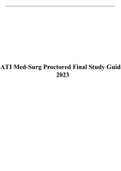Class notes
PSYB64 Textbook notes - Chapter 12 Learning and Memory
- Course
- PSYB64 (PSYB64)
- Institution
- University Of Toronto (U Of T )
Detailed textbook chapter notes for chapter 12 Learning and Memory. Freberg, L. (2018). Discovering Behavioral Neuroscience: An introduction to Biological Psychology. Cengage Learning.
[Show more]












